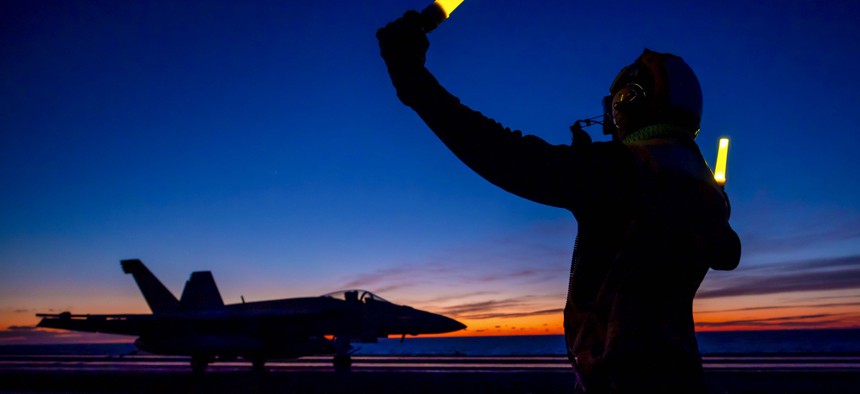
Navy Petty Officer 3rd Class Gzavel Bolton directs an F/A-18E Super Hornet on the flight deck of the USS Harry S. Truman in the Mediterranean Sea, Jan. 29, 2022. U.S. Navy / Seaman T'ara Tripp
After Deadly Aviation Crashes, Congress May Tighten Pentagon Focus on Why
2023 budget also seeks report on risks to anti-tank and anti-aircraft munition stockpiles after U.S. surge to Ukraine.
Updated Thursday 7:56 a.m. with Marine Corps crash.
Congress may tighten requirements on Pentagon aviation safety reporting following a string of crashes that have killed at least six and injured at least four servicemembers since March.
Those include the June 3 loss of an F/A-18E Super Hornet and pilot Lt. Richard Bullock and the June 6 crash of an AH-64 Apache helicopter that injured two Army crew members, as well as the March crash of a U.S. Marine Corps MV-22B Osprey in Norway that killed four.
Then on Wednesday, another Marine Corps MV-22 Osprey crashed in California. CBS News and The Los Angeles Times reported four of the five crew members were killed, but the Marine Corps had not confirmed the status of the crew as of Thursday morning.
It's a similar to a string of crashes that led Congress to take action in 2018, and in its mark for the 2023 National Defense Authorization Act released hours before yesterday's California crash, the House Armed Services readiness subcommittee appeared ready to do more, by inserting language requiring the Deputy Defense Secretary to report annually on the findings and focus of a joint aviation safety council that the Pentagon has still not created.
Following a string of deadly crashes in 2018, including the free-fall of a Puerto Rico Air National Guard C-130 that was caught on video, Congress established an independent entity, the National Commission on Military Aviation Safety, to dig further. In December 2020, the commission reported that since 2013, accidents had killed 224 pilots or crew, destroyed 186 aircraft, and cost $11.6 billion.
It also reported that there was no quick fix for the various factors that had led to those crashes. “The question of the next mishap was not hard to answer at one Marine base, where a junior Marine told the Commission that his unit was reusing expendable $5 filters on aircraft. The unit, he explained, still had missions to do even if there was no money to purchase new filters,” the commission reported in 2020.
The commission recommended that the Pentagon establish that joint safety council, to be led by the Deputy Defense Secretary, to get the services to uniformly report incidents so that causes could be more quickly identified.
On Wednesday, a defense official said in a statement that Deputy Defense Secretary Kathleen Hicks’ office “submitted an interim response to the National Commission on Military Aviation Safety Implementation Plan in late-March / early April 2022, and is actively working on the comprehensive response, which will likely be transmitted to Congress by the end of August.”
The commission also highlighted the hard-to-measure but deadly impact of late budgets. For at least 14 of the last 20 years Congress has not passed a budget on time. To keep things operating, it passes a continuing resolution, or “CR”, that doles out money at the previous year’s level. But those funds get eaten into by ever-rising personnel costs, decreasing the money available for training, operations, and maintenance. That leads to fewer flight hours and less maintenance, and a corresponding rise in the chance of a deadly accident or a parts failure—risks that do not drop quickly after the new budget arrives.
“Late funding, no matter the amount, cannot reverse the impact of months of insufficient flying hours, missing parts, and deferred maintenance. Timing is everything,” the commission found in 2020.
In its investigation of the Puerto Rico Air National Guard crash, the Air Force reported that a factor in the crash was the unit’s low morale and “culture of complacency” fed by spare-parts shortages that led “to long repair times and lower mission capable rates for their aircraft.”
“Because training is expensive, with fuel costs, maintenance costs, if the budget flow is disrupted, then you have to alter training as the money goes,” said Dan Grazier, a senior defense fellow at the Project on Government Oversight. “You end up cutting back. In the case of the aviation world, they are going to cut back on flying hours.”
Those hours are already low. Air Force fighter pilots are getting about 4.4 flights a month—about one flight a week—“and that's where you really have a hard time doing basic things,” Heritage Foundation senior defense fellow John Venable, a former F-16 pilot with more than 4,400 flight hours, said during a June 3 discussion with Air Force Secretary Frank Kendall.
“I'm not happy with where we are in terms of number of flying hours,” Kendall responded.
The bill also requires that each service assign a two-star general or admiral to implement recommendations stemming from accident investigations.
It asks the Government Accountability Office to investigate whether “operation and maintenance funding levels have impacted fighter readiness.”
Lawmakers are considering the readiness language and other provisions today and tomorrow for inclusion in the House’s 2023 defense bill. Other provisions addressing readiness include:
- Requiring the Air Force to reassess its plans for reducing its combat search and rescue HH-60W helicopters and whether those plans “meet the objectives of the most recent National Defense Strategy.”
- Requires the Army to submit a report on plans to reduce risk to the tactical missile supply chain, including specific risks to missile stockpiles, and potential options for surging production anti-air and anti-tank inventory following the U.S. surge of those weapons to Ukraine.
- Requires the Navy to report back on how it will ensure the tactical relevance and survivability of the F/A-18E/F with an advanced electronic warfare suite.
